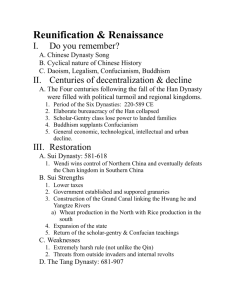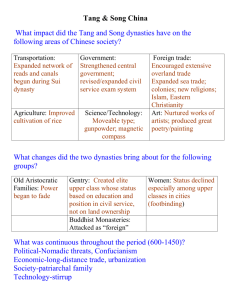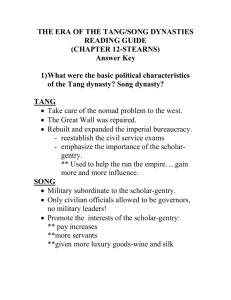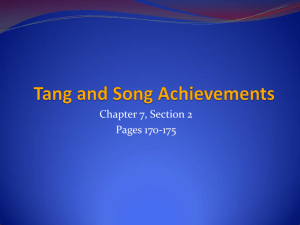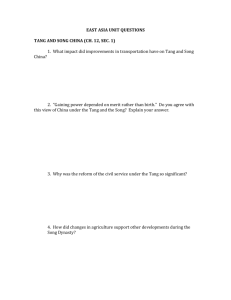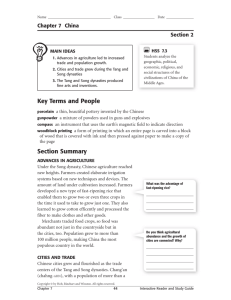Reunification and Renaissance in Chinese Civilization
advertisement
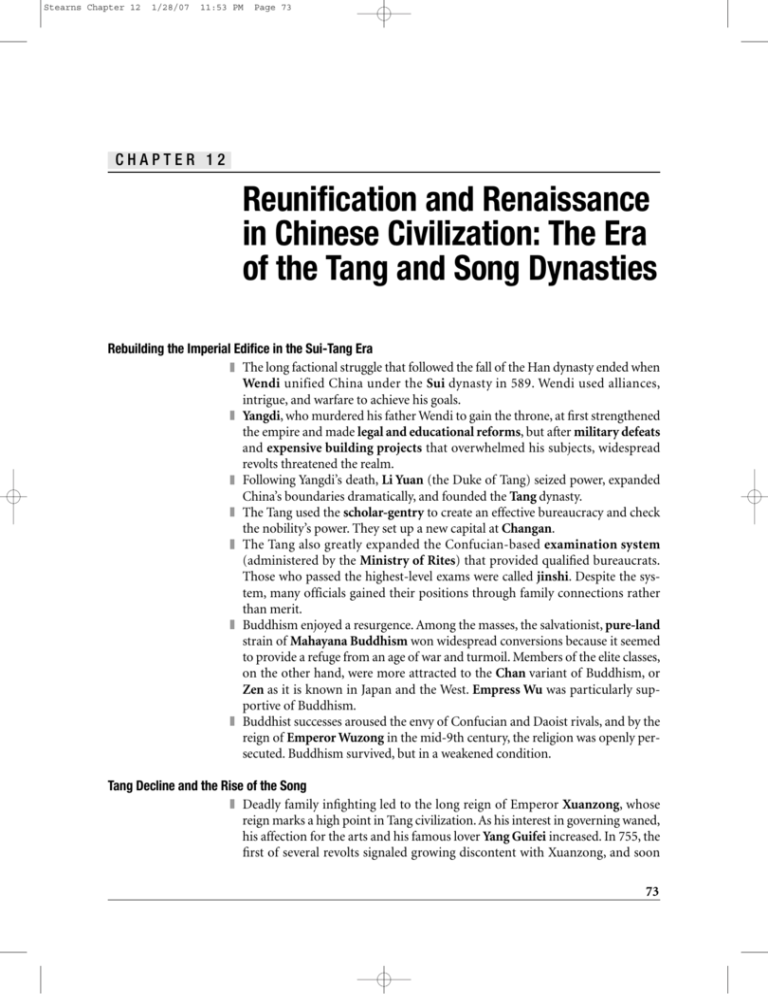
Stearns Chapter 12 1/28/07 11:53 PM Page 73 CHAPTER 12 Reunification and Renaissance in Chinese Civilization: The Era of the Tang and Song Dynasties Rebuilding the Imperial Edifice in the Sui-Tang Era The long factional struggle that followed the fall of the Han dynasty ended when Wendi unified China under the Sui dynasty in 589. Wendi used alliances, intrigue, and warfare to achieve his goals. Yangdi, who murdered his father Wendi to gain the throne, at first strengthened the empire and made legal and educational reforms, but after military defeats and expensive building projects that overwhelmed his subjects, widespread revolts threatened the realm. Following Yangdi’s death, Li Yuan (the Duke of Tang) seized power, expanded China’s boundaries dramatically, and founded the Tang dynasty. The Tang used the scholar-gentry to create an effective bureaucracy and check the nobility’s power. They set up a new capital at Changan. The Tang also greatly expanded the Confucian-based examination system (administered by the Ministry of Rites) that provided qualified bureaucrats. Those who passed the highest-level exams were called jinshi. Despite the system, many officials gained their positions through family connections rather than merit. Buddhism enjoyed a resurgence. Among the masses, the salvationist, pure-land strain of Mahayana Buddhism won widespread conversions because it seemed to provide a refuge from an age of war and turmoil. Members of the elite classes, on the other hand, were more attracted to the Chan variant of Buddhism, or Zen as it is known in Japan and the West. Empress Wu was particularly supportive of Buddhism. Buddhist successes aroused the envy of Confucian and Daoist rivals, and by the reign of Emperor Wuzong in the mid-9th century, the religion was openly persecuted. Buddhism survived, but in a weakened condition. Tang Decline and the Rise of the Song Deadly family infighting led to the long reign of Emperor Xuanzong, whose reign marks a high point in Tang civilization. As his interest in governing waned, his affection for the arts and his famous lover Yang Guifei increased. In 755, the first of several revolts signaled growing discontent with Xuanzong, and soon 73 Stearns Chapter 12 1/28/07 11:53 PM Page 74 nomadic tribesmen—former allies—were impinging on Tang territory with impunity. In 960, the scholarly general Zhao Kuangyin defeated most of the rivals scrounging for power after Xuanzong’s death and founded the Song dynasty. However, he could not defeat the Manchurian Liao dynasty (founded by Khitan peoples) in the north, a fact that would prove fatal in time. The Song favored the scholar-gentry at the expense of the military, which meant that the empire was never as formidable as the Tang. Accordingly, Confucian ideals were again emphasized. Zu Xi and the neoConfucians, or revivers of ancient Confucian teachings, believed that cultivating personal morality was the highest goal for humans, arguing that virtue could be attained through book learning and personal observation as well as through contact with men of wisdom and high morality. Signs of the Song dynasty’s decline included border kingdoms like the Tangut people’s kingdom of Xi Xia, disdain for military expenditures among the scholar-gentry, and Wang Anshi’s failed attempts to secure long-term reform. In 1115, a new nomadic contender, the Jurchens, overthrew the Liao dynasty of the Khitans and established the Jin kingdom north of the Song empire. What became known for the next century and a half as the Southern Song dynasty was a weak state politically, but radiant culturally. Tang and Song Prosperity: The Basis of a Golden Age Yangdi’s Grand Canal linked the original centers of Chinese civilization on the north China plain with the Yangtze River basin more than 500 miles to the south. The canal made it possible to transport grain from the fertile southern regions to the capital and to transfer food from the south to districts threatened by drought and famine in the north. Tang conquests led to increased trade and contact (primarily over the silk road and over the seas in Chinese junks) with civilizations to the west. Urban centers grew, and “flying money,” for example, was a sign of the increasing sophistication of Chinese trade. The movement of the population southward to the fertile valleys of the Yangtze and other river systems was part of a larger process of agrarian expansion that Tang and Song leaders encouraged. Agricultural improvements and leaders’ modestly successful attempts at land reform aided peasant quality of life. Both within the family and in society at large, women remained clearly subordinate to men. But some evidence suggests that, at least for women of the upper classes in urban areas, the opportunities for personal expression increased in the Tang and early Song. Neo-Confucian philosophers were leading advocates of male dominance. Men were allowed to have premarital sex without scandal, to take concubines if they could afford them, and to remarry if one or more of their wives died. No practice exemplifies the degree to which women in Chinese civilization were constricted and subordinated as dramatically as footbinding. The Tang and Song eras are remembered as a time of remarkable Chinese accomplishments in science, technology, literature, and the fine arts. 74 PART II: TOPICAL REVIEW WITH SAMPLE QUESTIONS AND ANSWERS AND EXPLANATIONS Stearns Chapter 12 1/28/07 11:53 PM Page 75 As the Confucian scholar-gentry supplanted the Buddhists as the major producers of art and literature, devotional objects and religious homilies gave way to a growing fixation on everyday life and the delights of the natural world. Li Bo’s poetry is a shining example of the everyday themes these intellectuals prized. Multiple-Choice Questions 1. The era of Tang and Song rule in China was known as a(n) (A) golden age of Chinese culture and accomplishments. (B) period of Buddhist dominance. (C) time where Christianity and Islam spread widely in China. (D) time of technological and commercial stagnation. (E) era where nomadic dynasties ruled most of China. 2. The Tang rulers were able to control potential nomadic threats to China by (A) bribery. (B) playing one nomadic group against another. (C) settling the nomads within the Chinese borders on land to farm. (D) intermarriage between the nomadic and Chinese ruling families. (E) diverting the nomads and sending them westward, away from China. 3. To administer China, the Tang and Song dynasties relied on (A) Turkish administrators. (B) the aristocracy. (C) merchants. (D) scholar-gentry. (E) Buddhist monks. 4. Buddhist successes in China during the Tang era (A) were opposed by the merchants and farmers. (B) provided the state with tax revenues and conscripted labor. (C) were counterbalanced by the introduction of Islam into China. (D) encouraged the scholar-officials, who were largely Buddhist. (E) led to persecutions and seizures of Buddhist monastic lands. 5. The major demographic change in China between 500 and 1000 C.E. was the (A) decline of cities as populations moved to the countryside. (B) widespread migration of Chinese to foreign lands. (C) population decrease in the north due to frequent nomadic raids. (D) large population increase in the south around the Yangtze. (E) internal migration of the populace from rural to urban areas. 6. Tang military expansion into central Asia (A) led to constant warfare between the Chinese and the Muslims. (B) promoted renewed commercial contacts between China and west Asia. (C) eliminated nomadic invasions. (D) obtained land to settle large Chinese population surpluses. (E) was easily defeated by the Turks and other pastoral nomads. 7. The technological advance that facilitated Chinese overseas trade was (A) the Grand Canal. (B) sericulture or the production of silk. (C) the manufacture of paper. (D) the introduction of gunpowder. (E) maritime tools such as the junk. 8. In order to lessen the influence of the aristocrats and bolster the position of the peasants, the Tang and Song monarchs CHAPTER 12: REUNIFICATION AND RENAISSANCE IN CHINESE CIVILIZATION 75 Stearns Chapter 12 1/28/07 11:53 PM Page 76 (A) broke up large landed estates and gave the land to the peasants. (B) established courts and rural police to protect the peasants. (C) set a percentage of governmental occupations and positions reserved for peasant applicants. (D) set up free, government-sponsored schools for the peasants. (E) recruited the military officers from the peasant class. 9. The invention of explosive powder (gunpowder) in China (A) was borrowed by the Chinese from the nomads. (B) allowed the Song to defeat the northern nomads. (C) led to the Arab conquest of China. (D) had little initial impact on warfare. (E) had no uses in Song society except for fireworks. 10. The high level of Chinese literacy was due to (A) free schooling for all classes of society. (B) the introduction of an alphabet during the Song dynasty. (C) the invention of movable-type printing and cheap paper. (D) the simplicity of the Chinese system of writing. (E) priests and Confucian theology, which insisted that Heaven wanted all people to be able to read and to write the Confucian classics. Free-Response Question How did the position of women change during the Tang and Song dynasties? ANSWERS AND EXPLANATIONS Multiple-Choice Questions 1. (A) is correct. Accomplishments of the era included the invention of explosive powder, the abacus, and moveable type, Li Bo’s poetry, and the first use of coal. 2. (B) is correct. Until political alliances within China broke down in the late 8th and 9th centuries, Tang leaders were very successful at playing nomadic groups off each other. 3. (D) is correct. The scholar-gentry, the civil examinations, and Confucian thought were related emphases of Tang and Song leaders. 4. (E) is correct. Perhaps a victim of its own success, Buddhism was persecuted openly in the time of Emperor Wuzong and never fully recovered. 5. (D) is correct. The movement of the population southward to the fertile valleys of the Yangtze and other river systems was part of a larger process of agrarian expansion in the Tang and Song period. 6. (B) is correct. In particular, the Silk Road reopened, paving the way for Persian and other goods to enter the empire overland. 7. (E) is correct. The junk, a new kind of ship, and the sea compass both improved Chinese sea trade considerably. 8. (A) is correct. These attempts at land reform were only moderately successful. 9. (D) is correct. Initially, explosive powder was used for crowd-pleasing fireworks displays, but by the late Song it gave China important military power. 10. (C) is correct. Europeans did not invent moveable type until centuries later. 76 PART II: TOPICAL REVIEW WITH SAMPLE QUESTIONS AND ANSWERS AND EXPLANATIONS Stearns Chapter 12 1/28/07 11:53 PM Page 77 Free-Response Essay Sample Response How did the position of women change during the Tang and Song dynasties? Though overall the position of women remained on a par with older Chinese societies, some changes occurred. In particular, the position of women showed signs of improving under the Tang and early Song eras, and then deteriorated steadily in the late Song. Upper class women in particular could expect more power in the Tang and early Song; for example, the Empresses Wu and Wei wielded great authority, and women had a number of marriage rights. However, with the neo-Confucian assertion of male dominance, these rights ebbed. Footbinding is perhaps the best example of this change, but numerous laws indicate that men in the late Song did not view women as equals. CHAPTER 12: REUNIFICATION AND RENAISSANCE IN CHINESE CIVILIZATION 77 Stearns Chapter 12 1/28/07 11:53 PM Page 78
